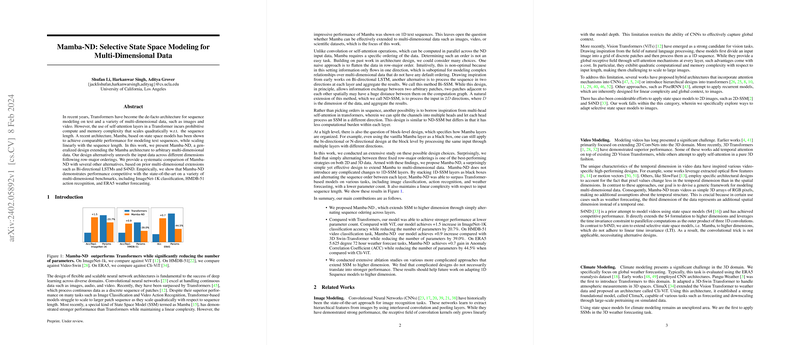An Analysis of Mamba-ND: Selective State Space Modeling for Multi-Dimensional Data
The paper "Mamba-ND: Selective State Space Modeling for Multi-Dimensional Data" investigates a novel approach to modeling multi-dimensional data using state space models (SSMs), departing from the conventional reliance on Transformer architectures. Mamba-ND, an extension of the Mamba architecture, aims to optimize sequence data processing by employing a linear complexity approach, contrasting the quadratic complexity inherent in Transformers.
Overview of Mamba-ND
Mamba-ND innovatively extends the Mamba architecture, previously demonstrated on one-dimensional (1D) text sequences, to adeptly handle multi-dimensional data such as images, video, and scientific datasets. It achieves this by unraveling input data through alternating row-major orderings, facilitating flexibility in data traversal that mimics attention mechanisms without the computational overhead. By systematically experimenting with various multi-dimensional extensions, this work offers a comprehensive comparative analysis against alternatives, including Bi-directional LSTMs and S4ND.
The Mamba-ND architecture effectively balances parallel compute efficiency with performance, employing a selective application of state space modeling across data dimensions. Its design simplicity facilitates the integration of one-dimensional selective state space model layers with alternating sequence ordering, directly impacting a model's global receptive field. This approach is evident in its strong empirical validation across benchmarks such as ImageNet-1K classification, HMDB-51 and UCF-101 action recognition, and ERA5 weather forecasting.
Key Technical Contributions
- Selective State Space Modeling: Mamba-ND leverages selective SSMs that diverge from linear time invariance assumptions. This flexibility allows dynamic adaptability to sequential variations unlike fixed kernel approaches.
- Reduced Complexity and Parameters: The architecture demonstrates significant parameter efficiency, outperforming Transformers on key multi-dimensional tasks while requiring fewer computational resources. This attribute is apparent in comparisons with ViT and Video-Swin models.
- Performance Across Diverse Tasks: The paper provides evidence of Mamba-ND's superior performance on tasks varying considerably in nature and dimensional complexity. On vision tasks, it exceeds Transformers' performance metrics, and likewise, it shows adeptness in handling 3D segmentation and forecasting scenarios.
Implications and Future Directions
Mamba-ND's approach signals a pertinent shift towards selective modeling in state space representations, which could redefine baseline architectures employed for multi-dimensional data sequences. This shift encourages exploration beyond conventional self-attention mechanisms, particularly for data-intensive applications where memory and computational efficiency are pivotal.
For future developments, the scalability of Mamba-ND across more diverse datasets and its integration into real-time processing tasks present promising avenues for research. Moreover, the exploration of alternative factorization strategies and layer embeddings might yield further efficiency gains or introduce more nuanced performance enhancements.
Conclusion
The paper presents a nuanced exploration of applying selective state space models to multi-dimensional data, showcasing Mamba-ND as a compelling alternative to traditionally dominant architectures like Transformers. By addressing compute and memory limitations while still achieving state-of-the-art performance, Mamba-ND provides a foundation for future research and implementation in complex multi-dimensional data processing applications. The work also opens discussions on refining neural network architectures to maximize efficiency without sacrificing model capacity or accuracy in handling vast, diverse data sequences.
